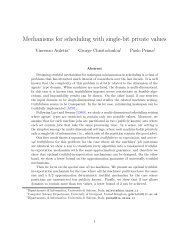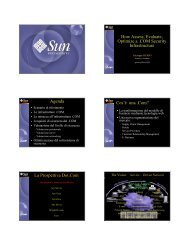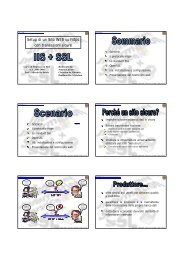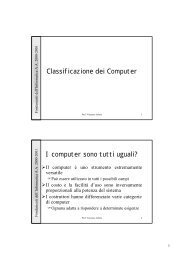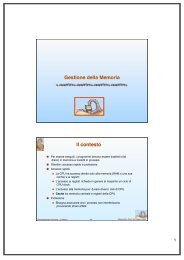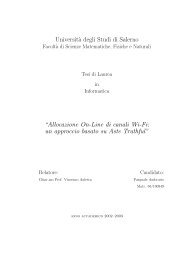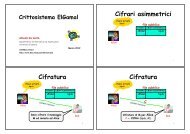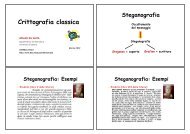Programmazione con Oggetti Distribuiti: Java RMI - Dipartimento di ...
Programmazione con Oggetti Distribuiti: Java RMI - Dipartimento di ...
Programmazione con Oggetti Distribuiti: Java RMI - Dipartimento di ...
You also want an ePaper? Increase the reach of your titles
YUMPU automatically turns print PDFs into web optimized ePapers that Google loves.
<strong>Programmazione</strong> <strong>con</strong> <strong>Oggetti</strong> <strong>Distribuiti</strong>: <strong>Java</strong> <strong>RMI</strong><br />
Vittorio Scarano<br />
II e<strong>di</strong>zione - Marzo 2010
A mio padre e a mia madre, ispiratori<br />
A mia moglie, dolce compagna, amica e <strong>con</strong>fidente<br />
Ai miei tre figli, gioielli e luce dei miei occhi<br />
iii
EMERGENCY è un’associazione italiana in<strong>di</strong>pendente<br />
e neutrale. EMERGENCY offre assistenza me<strong>di</strong>cochirurgica<br />
gratuita e <strong>di</strong> elevata qualità alle vittime<br />
civili delle guerre, delle mine antiuomo e della povertà.<br />
Dal 1994 più <strong>di</strong> 3 milioni <strong>di</strong> persone sono state curate<br />
gratuitamente in ospedali, cliniche e centri <strong>di</strong> riabilitazione<br />
<strong>di</strong> EMERGENCY dove inoltre è garantita<br />
la formazione del personale me<strong>di</strong>co locale.<br />
Tre ospedali, un centro <strong>di</strong> maternità e 29 posti <strong>di</strong><br />
primo soccorso in Afganistan, un ospedale e un posto <strong>di</strong> primo soccorso in Cambogia, un<br />
centro <strong>di</strong> riabilitazione in Iraq, un poliambulatorio per migranti a Palermo, un ospedale e<br />
un centro pe<strong>di</strong>atrico in Sierra Leone, una clinica pe<strong>di</strong>atrica e un centro <strong>di</strong> car<strong>di</strong>ochirurgia<br />
in Sudan, due centri pe<strong>di</strong>atrici in Darfur e in Repubblica Centrafricana, e un centro <strong>di</strong><br />
Ostetricia e Ginecologia in Nicaragua in costruzione.<br />
Ecco gli ospedali che Emergency ha voluto, ha costruito e tuttora gestisce grazie al <strong>con</strong>tributo<br />
<strong>di</strong> migliaia <strong>di</strong> persone.<br />
EMERGENCY<br />
Via Gerolamo Vida 11<br />
20127, Milano<br />
tel. 02/881881 - fax 02/86316336<br />
http://www.emergency.it<br />
e mail: info@emergency.it<br />
Conto corrente postale<br />
intestato a “EMERGENCY Ong Onlus”<br />
n. 2842 6203<br />
IBAN: IT37 Z076 0101 6000 0002 8426 203<br />
Conto corrente bancario<br />
intestato a “EMERGENCY Ong Onlus”<br />
IBAN: IT 02 X 05018 01600 000000130130<br />
presso Banca Etica, Filiale <strong>di</strong> Milano<br />
L’autore devolve interamente i propri proventi in favore dei progetti <strong>di</strong> Emergency.<br />
v
In<strong>di</strong>ce<br />
1 Introduzione 1<br />
1.1 I sistemi <strong>di</strong>stribuiti . . . . . . . . . . . . . . . . . . . . . . . . . . . . . . . . 2<br />
1.2 Un modello <strong>di</strong> riferimento: Open Distributed Processing . . . . . . . . . . . 3<br />
1.2.1 Le caratteristiche <strong>di</strong> un sistema <strong>di</strong>stribuito . . . . . . . . . . . . . . . 4<br />
1.2.2 I requisiti non funzionali <strong>di</strong> un sistema <strong>di</strong>stribuito . . . . . . . . . . . 5<br />
1.2.3 La trasparenza <strong>di</strong> un sistema <strong>di</strong>stribuito . . . . . . . . . . . . . . . . 7<br />
1.2.4 I <strong>di</strong>versi punti <strong>di</strong> vista (viewpoints) per un sistema <strong>di</strong>stribuito . . . . 10<br />
1.3 Il Middleware ad <strong>Oggetti</strong> <strong>Distribuiti</strong> . . . . . . . . . . . . . . . . . . . . . . . 13<br />
1.3.1 Il progenitore: Remote Procedure Calls (RPC) . . . . . . . . . . . . . 15<br />
1.3.2 Da RPC al Middleware ad <strong>Oggetti</strong> <strong>Distribuiti</strong> . . . . . . . . . . . . . . 15<br />
1.3.3 Esempi rappresentativi: CORBA, <strong>Java</strong> <strong>RMI</strong> e .NET . . . . . . . . . . . 16<br />
1.4 Il Middleware ad <strong>Oggetti</strong> <strong>Distribuiti</strong> nel Modello a Componenti . . . . . . . 17<br />
Note bibliografiche . . . . . . . . . . . . . . . . . . . . . . . . . . . . . . . . . . . 19<br />
Spunti per lo stu<strong>di</strong>o in<strong>di</strong>viduale . . . . . . . . . . . . . . . . . . . . . . . . . . . . 20<br />
Introduzione a <strong>Java</strong> <strong>RMI</strong> 25<br />
2 Dai socket agli oggetti remoti 25<br />
2.1 Introduzione . . . . . . . . . . . . . . . . . . . . . . . . . . . . . . . . . . . 26<br />
2.2 Un breve richiamo sulla programmazione <strong>con</strong> i socket . . . . . . . . . . . . 26<br />
2.2.1 I socket TCP . . . . . . . . . . . . . . . . . . . . . . . . . . . . . . . . 27<br />
2.2.2 Gli stream . . . . . . . . . . . . . . . . . . . . . . . . . . . . . . . . . 27<br />
2.2.3 HelloWorld <strong>con</strong> i socket . . . . . . . . . . . . . . . . . . . . . . . . . 28<br />
2.2.4 Un esempio <strong>di</strong> client-server <strong>con</strong> i socket . . . . . . . . . . . . . . . . 31<br />
2.3 Da un oggetto locale . . . . . . . . . . . . . . . . . . . . . . . . . . . . . . . . 34<br />
2.4 . . . all’oggetto remoto . . . . . . . . . . . . . . . . . . . . . . . . . . . . . . . 36<br />
2.4.1 Il server e la interfaccia remota . . . . . . . . . . . . . . . . . . . . . 37<br />
2.4.2 Il client . . . . . . . . . . . . . . . . . . . . . . . . . . . . . . . . . . 39<br />
2.4.3 Lo strato stub/skeleton . . . . . . . . . . . . . . . . . . . . . . . . . . 39<br />
2.4.4 La sequenza delle invocazioni . . . . . . . . . . . . . . . . . . . . . . 43<br />
2.4.5 Per lanciare la applicazione . . . . . . . . . . . . . . . . . . . . . . . 43<br />
2.5 In<strong>di</strong>rizzamento dell’oggetto remoto . . . . . . . . . . . . . . . . . . . . . . . 45<br />
2.5.1 Il Client . . . . . . . . . . . . . . . . . . . . . . . . . . . . . . . . . . 45<br />
2.5.2 Lo Skeleton . . . . . . . . . . . . . . . . . . . . . . . . . . . . . . . . 47<br />
2.6 Alcuni commenti <strong>con</strong>clusivi . . . . . . . . . . . . . . . . . . . . . . . . . . . 49<br />
2.7 Approfon<strong>di</strong>menti . . . . . . . . . . . . . . . . . . . . . . . . . . . . . . . . . 49<br />
2.7.1 Il funzionamento <strong>di</strong> getOutputStream() . . . . . . . . . . . . . . . . 49<br />
2.7.2 Conversione <strong>di</strong> Byte unsigned . . . . . . . . . . . . . . . . . . . . . . 50<br />
Note bibliografiche . . . . . . . . . . . . . . . . . . . . . . . . . . . . . . . . . . . 50<br />
Spunti per lo stu<strong>di</strong>o in<strong>di</strong>viduale . . . . . . . . . . . . . . . . . . . . . . . . . . . . 51<br />
vii
viii INDICE<br />
3 Presentazione <strong>di</strong> <strong>Java</strong> Remote Method Invocation 53<br />
3.1 Introduzione . . . . . . . . . . . . . . . . . . . . . . . . . . . . . . . . . . . 54<br />
3.2 Gli obiettivi della progettazione <strong>di</strong> <strong>Java</strong> <strong>RMI</strong> . . . . . . . . . . . . . . . . . . 54<br />
3.3 Il modello a oggetti <strong>di</strong>stribuiti <strong>di</strong> <strong>Java</strong> <strong>RMI</strong> . . . . . . . . . . . . . . . . . . . 56<br />
3.3.1 La struttura delle classi <strong>di</strong> <strong>Java</strong> <strong>RMI</strong> . . . . . . . . . . . . . . . . . . 56<br />
3.3.2 Il meccanismo <strong>di</strong> invocazione remota . . . . . . . . . . . . . . . . . . 58<br />
3.3.3 La <strong>di</strong>fferenza tra il modello a oggetti locale e quello remoto . . . . . 61<br />
3.4 La architettura <strong>di</strong> <strong>Java</strong> <strong>RMI</strong> . . . . . . . . . . . . . . . . . . . . . . . . . . . 62<br />
3.4.1 I tre layer della architettura . . . . . . . . . . . . . . . . . . . . . . . 62<br />
3.4.2 Distributed Garbage Collection . . . . . . . . . . . . . . . . . . . . . 66<br />
3.4.3 Caricamento <strong>di</strong>namico delle classi . . . . . . . . . . . . . . . . . . . 67<br />
3.5 Approfon<strong>di</strong>menti . . . . . . . . . . . . . . . . . . . . . . . . . . . . . . . . . 68<br />
3.5.1 L’eterogeneità nelle tecnologie ad oggetti <strong>di</strong>stribuiti . . . . . . . . . . 68<br />
3.5.2 La trasparenza degli oggetti <strong>di</strong>stribuiti . . . . . . . . . . . . . . . . . 70<br />
3.5.3 La sicurezza in <strong>Java</strong> . . . . . . . . . . . . . . . . . . . . . . . . . . . 74<br />
3.5.4 Il meccanismo <strong>di</strong> marshalling usato da <strong>Java</strong> <strong>RMI</strong> . . . . . . . . . . . 75<br />
Note bibliografiche . . . . . . . . . . . . . . . . . . . . . . . . . . . . . . . . . . . 76<br />
Spunti per lo stu<strong>di</strong>o in<strong>di</strong>viduale . . . . . . . . . . . . . . . . . . . . . . . . . . . . 78<br />
4 Un primo esempio <strong>con</strong> <strong>Java</strong> <strong>RMI</strong> 81<br />
4.1 Introduzione . . . . . . . . . . . . . . . . . . . . . . . . . . . . . . . . . . . 82<br />
4.2 Il processo <strong>di</strong> creazione <strong>di</strong> un programma <strong>Java</strong> <strong>RMI</strong> . . . . . . . . . . . . . . 82<br />
4.2.1 Definizione della interfaccia remota . . . . . . . . . . . . . . . . . . 82<br />
4.2.2 Implementazione del server . . . . . . . . . . . . . . . . . . . . . . . 83<br />
4.2.3 Compilazione del server . . . . . . . . . . . . . . . . . . . . . . . . . 83<br />
4.2.4 Compilazione <strong>con</strong> lo stub compiler rmic . . . . . . . . . . . . . . . . 84<br />
4.2.5 Servizio <strong>di</strong> naming: rmiregistry . . . . . . . . . . . . . . . . . . . . 85<br />
4.2.6 Esecuzione del server . . . . . . . . . . . . . . . . . . . . . . . . . . 85<br />
4.2.7 Registrazione del server sul servizio <strong>di</strong> naming . . . . . . . . . . . . 88<br />
4.2.8 Implementazione del client . . . . . . . . . . . . . . . . . . . . . . . 88<br />
4.2.9 Compilazione ed esecuzione del client . . . . . . . . . . . . . . . . . 89<br />
4.3 L’esempio HelloWorld . . . . . . . . . . . . . . . . . . . . . . . . . . . . . . 89<br />
4.3.1 Definizione della interfaccia remota . . . . . . . . . . . . . . . . . . 89<br />
4.3.2 Implementazione del server . . . . . . . . . . . . . . . . . . . . . . . 90<br />
4.3.3 Compilazione del server . . . . . . . . . . . . . . . . . . . . . . . . . 91<br />
4.3.4 Compilazione <strong>con</strong> lo stub compiler rmic . . . . . . . . . . . . . . . . 91<br />
4.3.5 Servizio <strong>di</strong> naming: rmiregistry . . . . . . . . . . . . . . . . . . . . 91<br />
4.3.6 Esecuzione del server . . . . . . . . . . . . . . . . . . . . . . . . . . 92<br />
4.3.7 Registrazione del server sul servizio <strong>di</strong> naming . . . . . . . . . . . . 92<br />
4.3.8 Implementazione del client . . . . . . . . . . . . . . . . . . . . . . . 92<br />
4.3.9 Compilazione ed esecuzione del client . . . . . . . . . . . . . . . . . 93<br />
4.4 La sicurezza e la policy del Security Manager . . . . . . . . . . . . . . . . . 93<br />
4.5 Commenti <strong>con</strong>clusivi . . . . . . . . . . . . . . . . . . . . . . . . . . . . . . . 94<br />
Note bibliografiche . . . . . . . . . . . . . . . . . . . . . . . . . . . . . . . . . . . 95<br />
Spunti per lo stu<strong>di</strong>o in<strong>di</strong>viduale . . . . . . . . . . . . . . . . . . . . . . . . . . . . 96<br />
<strong>Programmazione</strong> <strong>con</strong> <strong>Java</strong> <strong>RMI</strong> 99<br />
5 Design Pattern <strong>con</strong> <strong>Java</strong> <strong>RMI</strong> 99<br />
5.1 Introduzione . . . . . . . . . . . . . . . . . . . . . . . . . . . . . . . . . . . 100
INDICE ix<br />
5.2 L’Adapter . . . . . . . . . . . . . . . . . . . . . . . . . . . . . . . . . . . . . 100<br />
5.2.1 Un esempio <strong>di</strong> Adapter: un <strong>con</strong>tatore remoto . . . . . . . . . . . . . 100<br />
5.2.2 Contatore remoto: il server . . . . . . . . . . . . . . . . . . . . . . . 101<br />
5.2.3 Contatore remoto: il client . . . . . . . . . . . . . . . . . . . . . . . . 105<br />
5.2.4 Alcuni commenti all’esempio . . . . . . . . . . . . . . . . . . . . . . 106<br />
5.3 La Factory . . . . . . . . . . . . . . . . . . . . . . . . . . . . . . . . . . . . . 106<br />
5.3.1 Un esempio <strong>di</strong> Factory: HelloWorld multilingua . . . . . . . . . . . . 107<br />
5.3.2 HelloWorld multilingua: il server . . . . . . . . . . . . . . . . . . . . 107<br />
5.3.3 HelloWorld multilingua: il client . . . . . . . . . . . . . . . . . . . . 110<br />
5.3.4 Alcuni commenti all’esempio . . . . . . . . . . . . . . . . . . . . . . 111<br />
5.4 L’Observer . . . . . . . . . . . . . . . . . . . . . . . . . . . . . . . . . . . . . 111<br />
5.4.1 Un esempio <strong>di</strong> Observer: la callback per le architetture client-server . 112<br />
5.4.2 Awareness <strong>con</strong> callback: la architettura . . . . . . . . . . . . . . . . . 113<br />
5.4.3 Awareness <strong>con</strong> callback: lato client . . . . . . . . . . . . . . . . . . . 114<br />
5.4.4 Awareness <strong>con</strong> callback: lato server . . . . . . . . . . . . . . . . . . . 117<br />
5.4.5 Alcuni commenti all’esempio . . . . . . . . . . . . . . . . . . . . . . 119<br />
Note bibliografiche . . . . . . . . . . . . . . . . . . . . . . . . . . . . . . . . . . . 119<br />
Spunti per lo stu<strong>di</strong>o in<strong>di</strong>viduale . . . . . . . . . . . . . . . . . . . . . . . . . . . . 120<br />
6 Una chat <strong>con</strong> <strong>Java</strong> <strong>RMI</strong> 121<br />
6.1 Introduzione . . . . . . . . . . . . . . . . . . . . . . . . . . . . . . . . . . . 122<br />
6.1.1 Le funzionalità <strong>di</strong> una chat . . . . . . . . . . . . . . . . . . . . . . . 122<br />
6.2 Chat <strong>con</strong> i socket . . . . . . . . . . . . . . . . . . . . . . . . . . . . . . . . . 123<br />
6.2.1 Un esempio <strong>con</strong> socket TCP . . . . . . . . . . . . . . . . . . . . . . . 123<br />
6.2.2 Un esempio <strong>con</strong> socket UDP Multicast . . . . . . . . . . . . . . . . . 128<br />
6.2.3 Commenti e ulteriori sviluppi . . . . . . . . . . . . . . . . . . . . . . 131<br />
6.3 Una chat client-server <strong>con</strong> <strong>Java</strong> <strong>RMI</strong> . . . . . . . . . . . . . . . . . . . . . . 133<br />
6.3.1 La architettura software . . . . . . . . . . . . . . . . . . . . . . . . . 133<br />
6.3.2 Il server . . . . . . . . . . . . . . . . . . . . . . . . . . . . . . . . . . 133<br />
6.3.3 Il client . . . . . . . . . . . . . . . . . . . . . . . . . . . . . . . . . . 136<br />
6.3.4 Commenti e ulteriori sviluppi . . . . . . . . . . . . . . . . . . . . . . 139<br />
6.4 Una chat peer2peer . . . . . . . . . . . . . . . . . . . . . . . . . . . . . . . . 141<br />
6.4.1 Un primo esempio <strong>di</strong> peer . . . . . . . . . . . . . . . . . . . . . . . . 141<br />
6.4.2 Commenti e ulteriori sviluppi . . . . . . . . . . . . . . . . . . . . . . 146<br />
6.5 Approfon<strong>di</strong>menti . . . . . . . . . . . . . . . . . . . . . . . . . . . . . . . . . 147<br />
6.5.1 UDP e in<strong>di</strong>rizzi IP <strong>di</strong> gruppo . . . . . . . . . . . . . . . . . . . . . . . 147<br />
Note bibliografiche . . . . . . . . . . . . . . . . . . . . . . . . . . . . . . . . . . . 148<br />
Spunti per lo stu<strong>di</strong>o in<strong>di</strong>viduale . . . . . . . . . . . . . . . . . . . . . . . . . . . . 149<br />
7 Alcuni esercizi 151<br />
7.1 Introduzione . . . . . . . . . . . . . . . . . . . . . . . . . . . . . . . . . . . 152<br />
7.2 Una chat CS per “Cuori solitari” . . . . . . . . . . . . . . . . . . . . . . . . . 152<br />
7.2.1 Il testo dell’esercizio . . . . . . . . . . . . . . . . . . . . . . . . . . . 152<br />
7.2.2 Una soluzione . . . . . . . . . . . . . . . . . . . . . . . . . . . . . . . 152<br />
7.3 Una chat CS per un docente <strong>di</strong>spotico . . . . . . . . . . . . . . . . . . . . . . 159<br />
7.3.1 Un <strong>con</strong>fronto tra <strong>di</strong>fferenti strategie . . . . . . . . . . . . . . . . . . 160<br />
7.3.2 Una soluzione . . . . . . . . . . . . . . . . . . . . . . . . . . . . . . . 161<br />
Spunti per lo stu<strong>di</strong>o in<strong>di</strong>viduale . . . . . . . . . . . . . . . . . . . . . . . . . . . . 168
x INDICE<br />
Argomenti Avanzati su <strong>Java</strong> <strong>RMI</strong> 173<br />
8 Gestione <strong>di</strong>namica <strong>di</strong> <strong>RMI</strong> 173<br />
8.1 Introduzione . . . . . . . . . . . . . . . . . . . . . . . . . . . . . . . . . . . 174<br />
8.2 Caricamento <strong>di</strong>namico delle classi . . . . . . . . . . . . . . . . . . . . . . . . 174<br />
8.2.1 Il ClassLoader . . . . . . . . . . . . . . . . . . . . . . . . . . . . . . . 174<br />
8.2.2 Caratteristiche del caricamento <strong>di</strong>namico . . . . . . . . . . . . . . . 175<br />
8.2.3 Gli scenari <strong>di</strong> utilizzo . . . . . . . . . . . . . . . . . . . . . . . . . . . 175<br />
8.3 Stub e Skeleton: la evoluzione . . . . . . . . . . . . . . . . . . . . . . . . . . 183<br />
8.3.1 Stub e Skeleton versione JDK 1.1 . . . . . . . . . . . . . . . . . . . . 183<br />
8.3.2 Stub versione JDK 1.2 . . . . . . . . . . . . . . . . . . . . . . . . . . 187<br />
8.3.3 JDK 5: niente Stub e Skeleton! . . . . . . . . . . . . . . . . . . . . . 189<br />
Note bibliografiche . . . . . . . . . . . . . . . . . . . . . . . . . . . . . . . . . . . 193<br />
Spunti per lo stu<strong>di</strong>o in<strong>di</strong>viduale . . . . . . . . . . . . . . . . . . . . . . . . . . . . 194<br />
9 <strong>RMI</strong> e <strong>Java</strong> Enterprise E<strong>di</strong>tion 195<br />
9.1 Introduzione . . . . . . . . . . . . . . . . . . . . . . . . . . . . . . . . . . . 196<br />
9.2 <strong>Java</strong> Enterprise E<strong>di</strong>tion . . . . . . . . . . . . . . . . . . . . . . . . . . . . . . 196<br />
9.2.1 Le architetture multi-tier . . . . . . . . . . . . . . . . . . . . . . . . . 196<br />
9.2.2 La architettura <strong>di</strong> <strong>Java</strong> EE . . . . . . . . . . . . . . . . . . . . . . . . 197<br />
9.3 Corba e IIOP . . . . . . . . . . . . . . . . . . . . . . . . . . . . . . . . . . . 198<br />
9.4 <strong>Java</strong> <strong>RMI</strong>-IIOP . . . . . . . . . . . . . . . . . . . . . . . . . . . . . . . . . . 200<br />
9.4.1 <strong>Java</strong> <strong>RMI</strong> e Corba . . . . . . . . . . . . . . . . . . . . . . . . . . . . . 200<br />
9.4.2 Le <strong>di</strong>fferenze tra <strong>RMI</strong> e <strong>RMI</strong>-IIOP . . . . . . . . . . . . . . . . . . . . 200<br />
9.4.3 Un esempio in <strong>Java</strong> <strong>RMI</strong>-IIOP . . . . . . . . . . . . . . . . . . . . . . 201<br />
Note bibliografiche . . . . . . . . . . . . . . . . . . . . . . . . . . . . . . . . . . . 206<br />
Spunti per lo stu<strong>di</strong>o in<strong>di</strong>viduale . . . . . . . . . . . . . . . . . . . . . . . . . . . . 207
Prefazione<br />
Obiettivi<br />
Questo libro su <strong>Java</strong> <strong>RMI</strong> ha due obiettivi. Il primo è quello <strong>di</strong> fornire allo studente il<br />
collegamento tra i tra<strong>di</strong>zionali corsi <strong>di</strong> programmazione <strong>di</strong> rete, che sono basati sulla comunicazione<br />
basata su TCP/IP ed i socket, e i corsi <strong>di</strong> programmazione <strong>di</strong> applicazioni<br />
<strong>di</strong>stribuite che tipicamente usano strumenti <strong>di</strong> alto livello come il modello a componenti<br />
<strong>di</strong>stribuite (ambienti Enterprise) oppure il modello orientato ai servizi (ambienti Web Services).<br />
Quello che manca, e che si intende fornire <strong>con</strong> questo libro, è il collegamento che<br />
permette allo studente <strong>di</strong> comprendere in quale maniera <strong>Java</strong> Enterprise E<strong>di</strong>tion, ad esempio,<br />
realizza la infrastruttura <strong>di</strong> comunicazione tra oggetti, utilizzando <strong>Java</strong> Remote Method<br />
Invocation oppure quanto del modello delle architetture orientate ai servizi (Service<br />
Oriented Architecture) derivi <strong>di</strong>rettamente dai modelli <strong>di</strong> invocazione remota strettamente<br />
accoppiati (come <strong>Java</strong> <strong>RMI</strong>).<br />
Quin<strong>di</strong>, il viaggio che si intende far intraprendere allo studente illustrerà come la programmazione<br />
<strong>di</strong> rete serve alla invocazione remota <strong>di</strong> meto<strong>di</strong> che servono poi a realizzare<br />
la infrastruttura <strong>di</strong> comunicazione. In un certo senso, si vuole usare la programmazione<br />
<strong>di</strong> socket e la invocazione remota <strong>di</strong> meto<strong>di</strong> come la programmazione assembly per la programmazione<br />
<strong>con</strong> un linguaggio evoluto, illustrando i meccanismi e le tecnologie coinvolte<br />
nell’ambiente <strong>Java</strong>. Tutto questo passerà anche attraverso la presentazione <strong>di</strong> alcuni <strong>con</strong>cetti<br />
fondamentali per le architetture <strong>di</strong> sistemi <strong>di</strong>stribuiti per <strong>con</strong>testualizzare la presenza<br />
<strong>di</strong> <strong>Java</strong> <strong>RMI</strong>.<br />
Il se<strong>con</strong>do obiettivo è quello <strong>di</strong> fornire le basi per la programmazione <strong>di</strong>stribuita <strong>di</strong><br />
oggetti, sviluppando quin<strong>di</strong> un certo numero <strong>di</strong> esempi pratici che guideranno lo studente,<br />
a partire dalla implementazione <strong>con</strong> i socket, a realizzare semplici applicazioni che<br />
però serviranno ad evidenziare problematiche tipiche dei sistemi client-server e dei sistemi<br />
peer2peer.<br />
Dal punto <strong>di</strong> vista dello stile <strong>di</strong> programmazione, la scelta è stata quella <strong>di</strong> evitare <strong>di</strong><br />
sovraccaricare il co<strong>di</strong>ce, senza presentare, ad esempio, interfacce grafiche ma limitandosi<br />
alla shell in modo da limitare la quantità <strong>di</strong> co<strong>di</strong>ce da presentare. Il cosiddetto co<strong>di</strong>ng style<br />
<strong>di</strong> <strong>Java</strong> viene utilizzato, anche se, per ragioni <strong>di</strong> spazio e <strong>di</strong> efficacia grafica, molti dei commenti<br />
nel co<strong>di</strong>ce sono ridotti all’osso, e mancano del tutto i commenti <strong>Java</strong>Doc. Questo<br />
stile <strong>di</strong> programmazione (utilizzato per rendere più agevole lo stu<strong>di</strong>o e la presentazione<br />
grafica) non è da ritenere un suggerimento, anzi! Sia ben chiaro allo studente che commenti<br />
adeguati e informativi sono estremamente utili per la manutenzione e la evoluzione<br />
del software e che la presentazione stringata è esclusivamente per limitare la lunghezza<br />
del co<strong>di</strong>ce stampato.<br />
Struttura del libro<br />
Il libro <strong>con</strong>sta <strong>di</strong> tre parti. Nella prima si introduce <strong>Java</strong> Remote Method Invocation attraverso<br />
l’utilizzo dei socket. Nella se<strong>con</strong>da si affrontano i <strong>di</strong>versi esempi <strong>di</strong> programmazione<br />
xi
xii INDICE<br />
usando <strong>Java</strong> <strong>RMI</strong>, allo scopo <strong>di</strong> introdurre tecniche e meto<strong>di</strong> utili per la realizzazione <strong>di</strong><br />
semplici applicazioni remote. Nella terza parte si trovano alcuni approfon<strong>di</strong>menti sulla<br />
struttura interna <strong>di</strong> <strong>Java</strong> <strong>RMI</strong>, <strong>con</strong> la capacità <strong>di</strong> gestire a run-time le invocazioni, e<br />
<strong>RMI</strong>-IIOP.<br />
A chi si rivolge il libro<br />
Il libro può essere utilizzato come testo <strong>di</strong> riferimento per corsi universitari <strong>di</strong> <strong>Programmazione</strong><br />
Distribuita <strong>di</strong> I livello (terzo anno) oppure <strong>di</strong> II livello (primo anno) in Informatica<br />
e Ingegneria Informatica. Si suppone che gli studenti abbiano una buona <strong>con</strong>oscenza <strong>di</strong><br />
<strong>Java</strong>, <strong>con</strong> esperienza nell’uso <strong>di</strong> Integrated Develoment Environment (IDE) e qualche <strong>con</strong>oscenza<br />
<strong>di</strong> base <strong>di</strong> Ingegneria del Software. Tra le competenze specifiche <strong>di</strong> <strong>Java</strong> che<br />
sono necessarie, una qualche semplice esperienza <strong>con</strong> i socket (anche in altri linguaggi) e<br />
una semplice <strong>con</strong>oscenza dei thread.<br />
Il materiale del libro può essere usato per un corso da 4-6 CFU, a se<strong>con</strong>da del livello <strong>di</strong><br />
dettaglio e delle esercitazioni da fare in laboratorio (qualora previsto).<br />
Gli strumenti utilizzati<br />
Composizione tipografica. Per scrivere questo libro è stato utilizzato LaTeX ed in particolare<br />
la versione per Windows <strong>di</strong>stribuita <strong>con</strong> MiKTeX 2.8 (http://www.miktex.org).<br />
TeXlipse 1.2.2 (http://texlipse.sourceforge.net/) è un plugin <strong>di</strong> Eclipse che è stato<br />
usato per facilitare la composizione.<br />
Per la traduzione <strong>di</strong> programmi <strong>Java</strong> in LaTeX si è utilizzato, invece, <strong>Java</strong>2HTML versione<br />
1.5.0 (http://www.java2html.de) che permette anche la <strong>con</strong>versione da <strong>Java</strong> in LaTeX,<br />
<strong>con</strong> il syntax-coloring ed è <strong>di</strong>sponibile anche come plugin per Eclipse. Per la creazione delle<br />
immagini, si usa il plugin <strong>di</strong> Eclipse eDump 1.7.1 (www.bdaum.de) che fornisce la possibilità<br />
<strong>di</strong> catturare immagini delle varie componenti <strong>di</strong> Eclipse <strong>con</strong> notevole flessibilità.<br />
Linguaggio e ambiente integrato <strong>di</strong> sviluppo. In generale, si è utilizzata la ultima versione<br />
<strong>di</strong>sponibile al momento della <strong>Java</strong> VM <strong>di</strong> Sun, vale a <strong>di</strong>re la versione <strong>Java</strong> SE Development<br />
Kit (JDK) 6 Update 11. Insieme ad essa, suggeriamo <strong>di</strong> scaricare in locale la<br />
documentazione <strong>Java</strong> <strong>di</strong>sponibile sul sito, che porta una notevole quantità <strong>di</strong> informazioni<br />
e <strong>di</strong> guide per i vari argomenti.<br />
Per la scrittura e la documentazione dei programmi <strong>di</strong> esempio si + usato Eclipse<br />
(http://www.eclipse.org), versione 3.4.1 <strong>con</strong> il plugin per eUML2 Free <strong>di</strong> Soyatec versione<br />
3.2.1 (http://www.soyatec.com/euml2/).<br />
Convenzioni<br />
L’uso e l’abuso della lingua inglese. In questo libro si cerca <strong>di</strong> evitare l’uso <strong>di</strong> forzate<br />
traduzioni <strong>di</strong> termini inglesi che sono oramai <strong>di</strong>ventati <strong>di</strong> uso tecnico. Ben lungi dal prefigurarsi<br />
come sud<strong>di</strong>tanza linguistica verso oltreoceano, questa scelta è motivata dal fatto<br />
che questo ben prepara gli studenti <strong>di</strong> oggi che, da professionisti dell’informatica <strong>di</strong> domani,<br />
si troveranno, necessariamente, a <strong>con</strong>tatto <strong>con</strong> documentazione <strong>di</strong> tecnologia recente<br />
che sarà <strong>di</strong>sponibile, probabilmente, solamente in inglese tecnico.
INDICE xiii<br />
Convenzioni tipografiche. Per in<strong>di</strong>care una sessione <strong>di</strong> lavoro ad una shell (come ad<br />
esempio per la compilazione o esecuzione <strong>di</strong> un programma) si è scelto <strong>di</strong> utilizzare come<br />
esempio una semplice shell DOS 1 . Per rappresentare una sessione useremo la seguente<br />
<strong>con</strong>venzione:<br />
Z:\>echo Ciao Ciao<br />
Z:\><br />
Per in<strong>di</strong>care un listato <strong>di</strong> una classe <strong>Java</strong> <strong>di</strong> nome Hello.java si utilizzerà questo<br />
standard:<br />
HelloWorld.java<br />
1 // Una classe <strong>di</strong> esempio<br />
2 public class HelloWorld {<br />
3 public static void main(String[] args) {<br />
4 System.out.println("Hello World!");<br />
5 }<br />
6 }<br />
Fine: HelloWorld.java<br />
In generale, coman<strong>di</strong> da shell vengono in<strong>di</strong>cati in grassetto, come ad esempio, il compilatore<br />
<strong>Java</strong> javac.<br />
1 In alternativa, si può utilizzare un plugin per Eclipse chiamato WickedShell (http://www.wickedshell.<br />
net) che permette <strong>di</strong> creare shell molto flessibili come view <strong>di</strong> Eclipse.
xiv INDICE
Prefazione alla se<strong>con</strong>da e<strong>di</strong>zione<br />
Questa e<strong>di</strong>zione aggiunge alla precedente la terza parte, <strong>con</strong> gli argomenti avanzati: gestione<br />
<strong>di</strong>namica e <strong>RMI</strong>-IIOP. Ovviamente, sono stati corretti anche gli errori, così come<br />
segnalati dai precisi e puntuali commenti che gli studenti del corso <strong>di</strong> <strong>Programmazione</strong><br />
Distribuita del corso <strong>di</strong> Laurea in Informatica dell’Università <strong>di</strong> Salerno hanno fornito,<br />
durante l’anno accademico 2008-2009.<br />
Ringrazio sentitamente tutti gli studenti che hanno inviato commenti, suggerimenti,<br />
correzioni, perchè il libro ne ha beneficiato notevolmente, e <strong>con</strong> questo, spero, ne<br />
beneficeranno anche i loro colleghi che lo useranno per lo stu<strong>di</strong>o negli anni successivi.<br />
Anche i <strong>di</strong>ritti <strong>di</strong> questa II e<strong>di</strong>zione saranno interamente versati ad Emergency, nel<br />
ricordo <strong>di</strong> Teresa Sarti Strada, scomparsa il 1 o settembre 2009.<br />
xv
xvi INDICE



